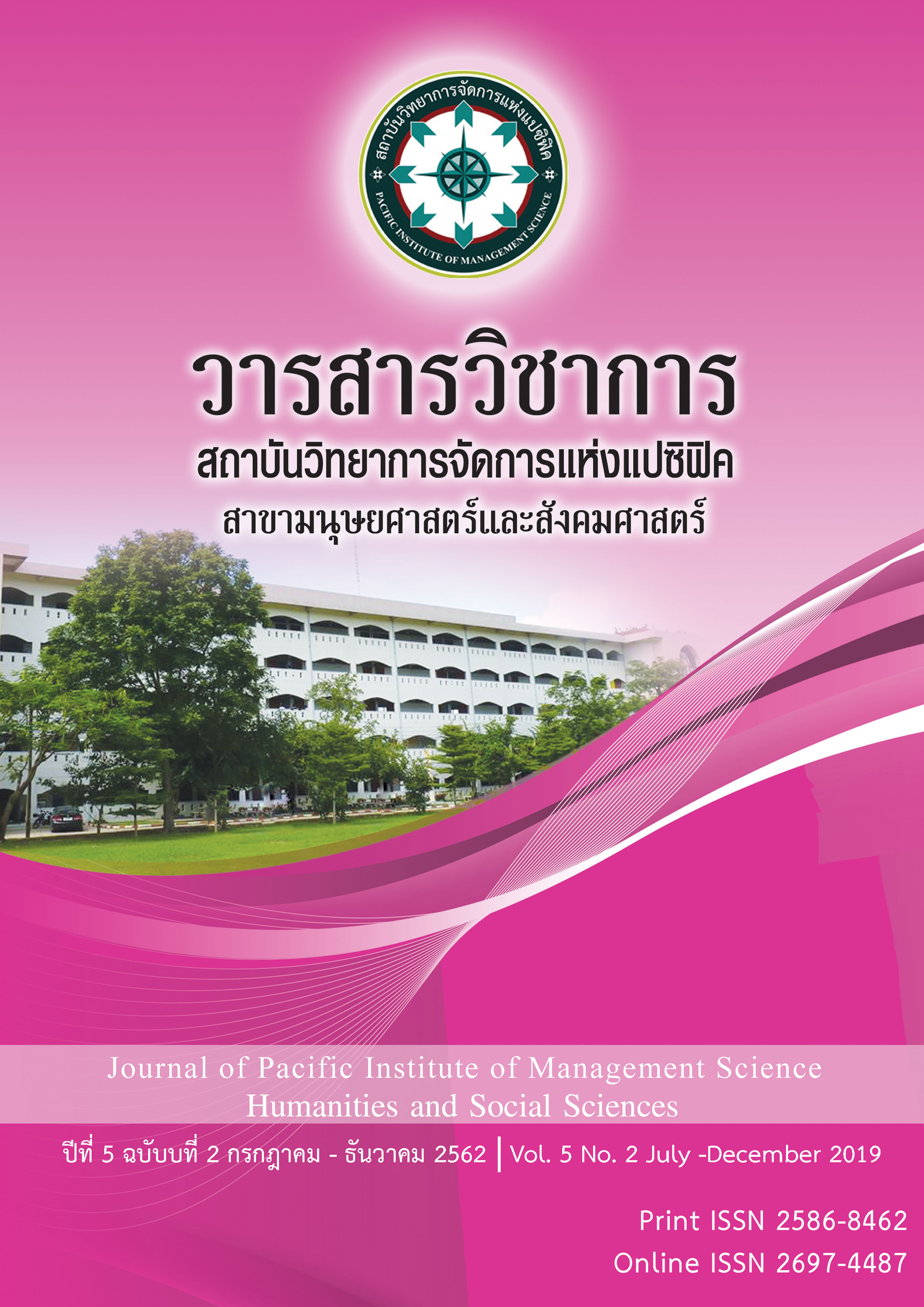Effectiveness of Group Cognitive Behavioral Therapy Program Combining Meditation on Nursing Students’s Anxiety
Keywords:
Cognitive Behavioral Therapy, Meditation, Anxiety, Nursing studentsAbstract
The purpose of this quasi – experimental research was to study the effects of group cognitive behavioral therapy program combining with meditation on nursing students’s anxiety. The research design was a randomize two – group pre and post test design. The subjects were 56 nursing students at faculty of Nursing Pathumthani University in Pathumthani Province. Simple random sampling technique used for both the experimental and control groups (28 each) . The experimental group counseling program was developed by the investigator according to the concepts of Cognitive Behavioral Therapy (CBT) and combining with meditation. The control group received only routine guidance.
The instruments were two kinds of tools used in this study : 1 ) One tool used was the program was developed by the investigator according to the concepts of CBT and combining with meditation and The Media for teaching meditation. 2) The second tool used was a Demographic Data From, Anxiety Questionnaire based on 1Speilberger’s STALForm X1 ( Thai version) . Cronbach’s Alpha Coefficient Formula for the Anxiety Questionnaire was 0.78 respectively. Descriptive statistics were used to assess the demographic information. The difference of nursing students anxiety mean scores before and after intervention within group and that of between the experimental and control group was analyzed using t-test.
The Findings were as follows:
1. The subjects in the experimental group who were given treatment by the group cognitive behavioral therapy program combining with meditation had significantly lower anxiety mean scores than before intervention . (p < .005)
2. The subjects in the experimental group who were given treatment by the group cognitive behavioral therapy program combining with meditation had significantly lower anxiety mean scores than the control group. (p < .005)
This study show that after given treatment by group cognitive behavioral therapy program combining with meditation effectively reduce anxiety levels of nursing students had a positive thinking with the problem and to confront problems effectively.
References
นันทวัช สิทธิรักษ์ และคณะ. (2558). จิตเวช ศิริราช DSM-5 / ภาควิชาจิตเวชศาสตร์ คณะแพทยศาสตร์ ศิริราชพยาบาล. พิมพ์ครั้งที่ 2 กรุงเทพฯ: มหาวิทยาลัยมหิดล คณะแพทยศาสตร์ โรงพยาบาล รามาธิบดี.
ปราโมทย์ สุขนิชย์ และ มาโนช หล่อตระกูล. (2541). คู่มือการวินิจฉัยและดูแลรักษาผู้ป่วยโรควิตกกังวล. (ฉบับปรับปรุงครั้งที่ 2). กรุงเทพฯ: เอส.ซี.พริ้นท์.
พระธรรมปิฎก. (2542). วิธีคิดตามหลักพุทธธรรม. พิมพ์ครั้งที่ 6. กรุงเทพฯ: สยาม.
พระไพศาล วิสาโล. (2559). ความสุขที่ปลายจมูก. พิมพ์ครั้งที่ 9. กรุงเทพฯ: เครือข่ายพุทธิกา.
พิมพิมล วงศ์ไชยา และคณะ. (2557). ความวิตกกังวลและความรู้สึกเป็นส่วนหนึ่งต่อหอผู้ป่วยของนักศึกษา พยาบาลศาสตรบัณฑิตที่ฝึกปฏิบัติวิชาสุขภาพจิตและการพยาบาลจิตเวช. วารสารวิทยาลัย พยาบาลบรมราชชนนี อุตรดิตถ์, ปีที่ 6 ฉบับที่ 2 : กรกฎาคม - ธันวาคม 2557.
ไพรัช วงศ์ศรีตระกูล. (2554). ปัจจัยทางการศึกษาที่มีผลต่อความเครียดและความวิตกกังวลของนักศึกษา มหาวิทยาลัยธนบุรี. การประชุม วิชาการ มสธ. วิจัย ประจําปี 2554. 124-135.
พุทธทาสภิกขุ. (2536). วิธีฝึกสมาธิวิปัสสนาฉบับสมบูรณ์. กรุงเทพฯ: รุ่งแสงการพิมพ์.
มาโนช หล่อตระกูล และ ปราโมทย์ สุขนิชย์. (2552). จิตเวชศาสตร์ รามาธิบดี. พิมพ์ครั้งที่ 3 กรุงเทพฯ: ภาควิชาจิตเวชศาสตร์ คณะแพทยศาสตร์ โรงพยาบาลรามาธิบดี มหาวิทยาลัยมหิดล.
ยุพาพักตร์ รักมณีวงษ์และคณะ. (2554). ผลของโปรแกรมกลุ่มบําบัดตามแนวคิดการปรับความคิดและ พฤติกรรม ร่วมกับการฝึกอานาปานสติบําบัดสมาธิต่อความวิตกกังวลในนิสิตพยาบาล. โครงการวิจัย ของคณะพยาบาลศาสตร์ มหาวิทยาลัยนเรศวร.
ศุภวรรณ ธนุภาพรังสรรค์ และ มาลีวัล เลิศสาครศิริ. (2559). ผลของการใช้รูปแบบการฝึกสมาธิโดยบูรณา การสติปัฏฐาน 4 กับเอสเคที 1 ต่อความสามารถทางสมอง ความตระหนักรู้ในตนเองและสัมฤทธิ์ ผลทางการเรียนของนักศึกษาพยาบาล. วารสารพยาบาลศาสตร์สงขลานครินทร์ ปีที่ 36 ฉบับพิเศษ กันยายน-ธันวาคม, หน้า 13-26.
สายฝน เอกวรางกูร. (2558). การพยาบาลจิตเวชและสุขภาพจิต: ศาสตร์และศิลป์สู่การปฏิบัติ 1. กรุงเทพฯ: โรงพิมพ์ไทม์ พริ้นติ้ง.
สมพร กันทรดุษฏี เตรียมชัยศรี. (2559). สมาธิบําบัดแบบ SKT. ( ออนไลน์). กรุงเทพ: คณะสาธารณสุข มหาวิทยาลัยมหิดล.
สมโภชน์ เอี่ยมสุภาษิต. (2541). ทฤษฎีและเทคนิคการปรับพฤติกรรม. พิมพ์ครั้งที่ 3. กรุงเทพฯ: จุฬาลงกรณ์มหาวิทยาลัย.
สุจิตรา กฤติยาวรรณ. (2547). ผลของการให้คําปรึกษารายกลุ่มตามแนวคิดการปรับเปลี่ยนความคิดและ พฤติกรรม ต่อการลดภาวะวิตกกังวลในนักศึกษาพยาบาล. วิทยานิพนธ์ปริญญาพยาบาลศาสตร มหาบัณฑิต บัณฑิตวิทยาลัย มหาวิทยาลัยขอนแก่น.
อรพรรณ ลือบุญธวัชชัย.( 2545). การพยาบาลสุขภาพจิตและจิตเวช. พิมพ์ครั้งที่ 2. กรุงเทพฯ: โรงพิมพ์ด่าน สุทธาการพิมพ์ .
Beck, A. T. (1976). Cognitive Therapy and the Emotion disorders. New York: International universities Press.
Beck, A. T. (1995). Cognitive Therapy : basics and beyond, New York: Guilford.
Gail W. Stuart., (1998). Cognitive Behavior Therapy. M.C. Escher/Coordon Art, Baarn, Halland.
Joyce Bonnie S. (1996). Cognitive Therapy, New York: Guilford Press.
Lazarus, R. S. & Folkman, S. (1984). Stress appraisal and coping. New York: Springer.
Moscaritoto, L. M. (2009). Interventional strategies to decrease nursing student anxiety in the clinical learning environment. Journal of Nursing Education, 48(1), 17-24.
Selye, H. (1986). The Stress of Life. New York: McGraw-Hill.
Speilberger, C. D. (1983). Manual for the State-Trait Anxiety Inventory (STAI). Palo Alto: Consulting Psychologist press.
Downloads
Published
Issue
Section
License
บทความที่ได้รับการตีพิมพ์เป็นลิขสิทธิ์ของ สถาบันวิทยาการจัดการแห่งแปซิฟิค
ข้อความที่ปรากฏในบทความแต่ละเรื่องในวารสารวิชาการเล่มนี้เป็นความคิดเห็นส่วนตัวของผู้เขียนแต่ละท่านไม่เกี่ยวข้องกับสถาบันวิทยาการจัดการแห่งแปซิฟิค และคณาจารย์ท่านอื่นๆในสถาบันฯ แต่อย่างใด ความรับผิดชอบองค์ประกอบทั้งหมดของบทความแต่ละเรื่องเป็นของผู้เขียนแต่ละท่าน หากมีความผิดพลาดใดๆ ผู้เขียนแต่ละท่านจะรับผิดชอบบทความของตนเองแต่ผู้เดียว







